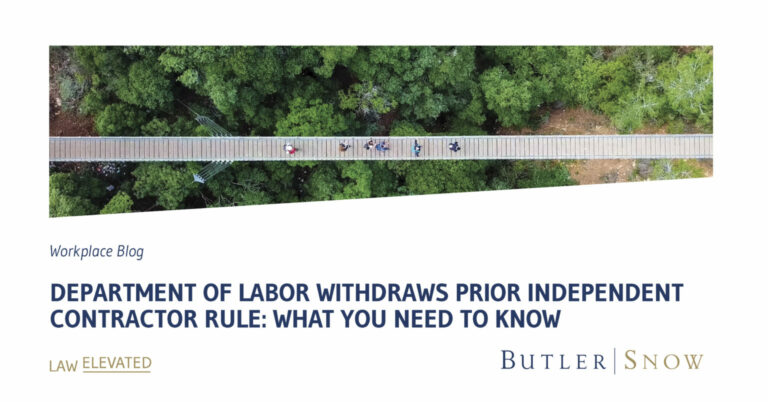Last month the Department of Labor (“DOL”) issued a Final Rule withdrawing the Trump Administration’s attempt to revise the DOL’s interpretation of independent contractor status under the Fair Labor Standards Act (“FLSA”). The net effect of this withdrawal is that the independent contractor analysis under the FLSA remains the same as it has been for several decades.
In January, the Trump DOL issued an Independent Contractor Rule that was set to take effect March 8 of this year. When it released the new rule, the DOL said it was making changes “to promote certainty for stakeholders, reduce litigation, and encourage innovation in the economy.”[1] That proposal placed a strong emphasis on two factors – (1) the nature and degree of the worker’s control over the work, and (2) the worker’s opportunity for profit or loss.
In the DOL’s explanation of its withdrawal of the proposed rule, it said that “[n]umerous state officials, members of Congress, labor unions, social justice organizations, worker advocacy groups, and individual commenters wrote in support of the Department’s proposal to withdraw the Independent Contractor Rule.” The DOL explained that these “commenters expressed opposition to the Independent Contractor Rule predominantly on the basis that, in their view, the Rule would have facilitated the exploitation of workers reclassified or misclassified as independent contractors as a consequence of the Rule.”
The Trump DOL’s rule never took effect and the current DOL’s withdrawal of proposed rule returns the issue to the status quo.
So what is the proper analysis?
Since the 1940’s federal courts have utilized an “economic realities” test. As the Fifth Circuit (which has jurisdiction over the federal courts located in Mississippi, Texas and Louisiana) has said, “[t]o determine if a worker qualifies as an employee, we focus on whether, as a matter of economic reality, the worker is economically dependent upon the alleged employer or is instead in business for himself.”[2] In order to make that determination, the Court said it considers “five non-exhaustive factors:”
- the degree of control exercised by the alleged employer;
- the extent of the relative investments of the worker and the alleged employer;
- the degree to which the worker’s opportunity for profit or loss is determined by the alleged employer;
- the skill and initiative required in performing the job; and
- the permanency of the relationship.”[3]
The Court explained that “[n]o single factor is determinative. Rather, each factor is a tool used to gauge the economic dependence of the alleged employee, and each must be applied with this ultimate concept in mind.”[4] Furthermore, in analyzing these factors, the courts look to facts – not contractual language.[5]
The analysis is fact-sensitive.
Obviously, then, each situation is fact-sensitive. Determining if a worker is an independent contractor or an employee is not subject to a clear “bright line” test. The Fifth Circuit has said that “[n]o hard and fast rule can be stated for determining whether a particular relationship is one of employer and employee or contractee and independent contractor, and the nature of the relationship is a question of fact to be determined from the facts of the particular case.[6]
Does this matter to employers?
The “independent contractor/employee” distinction has always mattered. Employers should always be mindful of ensuring they have workers properly classified as an independent contractor or employee. Legal issues include:
- Tax liability (Federal, State and Local)
- retroactive contributions to FICA and federal unemployment taxes
- civil penalties, including interest
- Overtime liability (unless the individual is exempt from the wage and hour laws)
- Liability for employee benefit plans under ERISA (back contributions for benefits, e.g., health, retirement, vacation, sick pay)
- Workers Compensation issues
- Unemployment insurance premiums
- Impact on the number of employees for purposes of determining whether federal statutes are applicable (e.g., Affordable Care Act, FMLA, Title VII, ADEA, ADA, etc.)
Conclusion
This issue is challenging, and getting it wrong can have significant consequences – monetary and non-monetary. Confirming this challenge, the Supreme Court has said that “[f]ew problems in the law have given greater variety of application and conflict in results than the cases arising in the borderland between what is clearly an employer-employee relationship and what is clearly one of independent entrepreneurial dealing.”[7]
If you have questions about whether your “independent contractor” truly is such, one of our Labor and Employment attorneys will be glad to discuss this with you.
[1] https://www.federalregister.gov/documents/2021/01/07/2020-29274/independent-contractor-status-under-the-fair-labor-standards-act
[2] Hopkins v. Cornerstone Am., 545 F.3d 338, 343 (5th Cir. 2008) (citing Herman v. Express Sixty–Minutes Delivery Serv., Inc., 161 F.3d 299, 303 (5th Cir.1998)).
[3] Id.
[4] Id. (citing Brock v. Mr. W Fireworks, Inc., 814 F.2d 1042, 1043–44 (5th Cir.1987))
[5] See, e.g., Beliz v. W.H. McLeod & Sons Packing Co., 765 F.2d 1317, 1329 (5th Cir. 1985) (“The principles governing employer status … turn on economic reality, not contractual niceties.”)
[6] Texas Carbonate Co. v. Phinney, 307 F.2d 289, 292 (5th Cir. 1962).
[7] N.L.R.B. v. Hearst Publications, 322 U.S. 111, 121, 64 S. Ct. 851, 856, 88 L. Ed. 1170 (1944), overruled in part by Nationwide Mut. Ins. Co. v. Darden, 503 U.S. 318, 112 S. Ct. 1344, 117 L. Ed. 2d 581 (1992)
